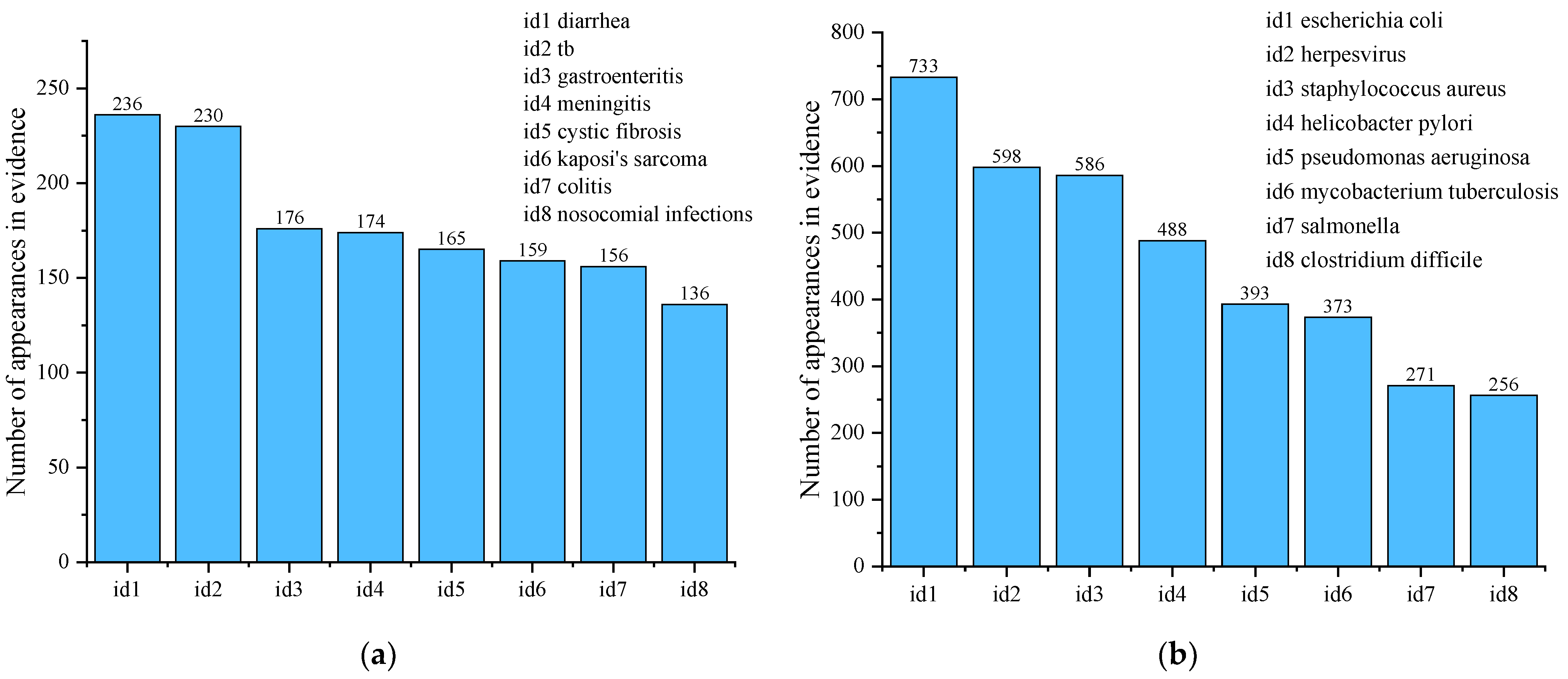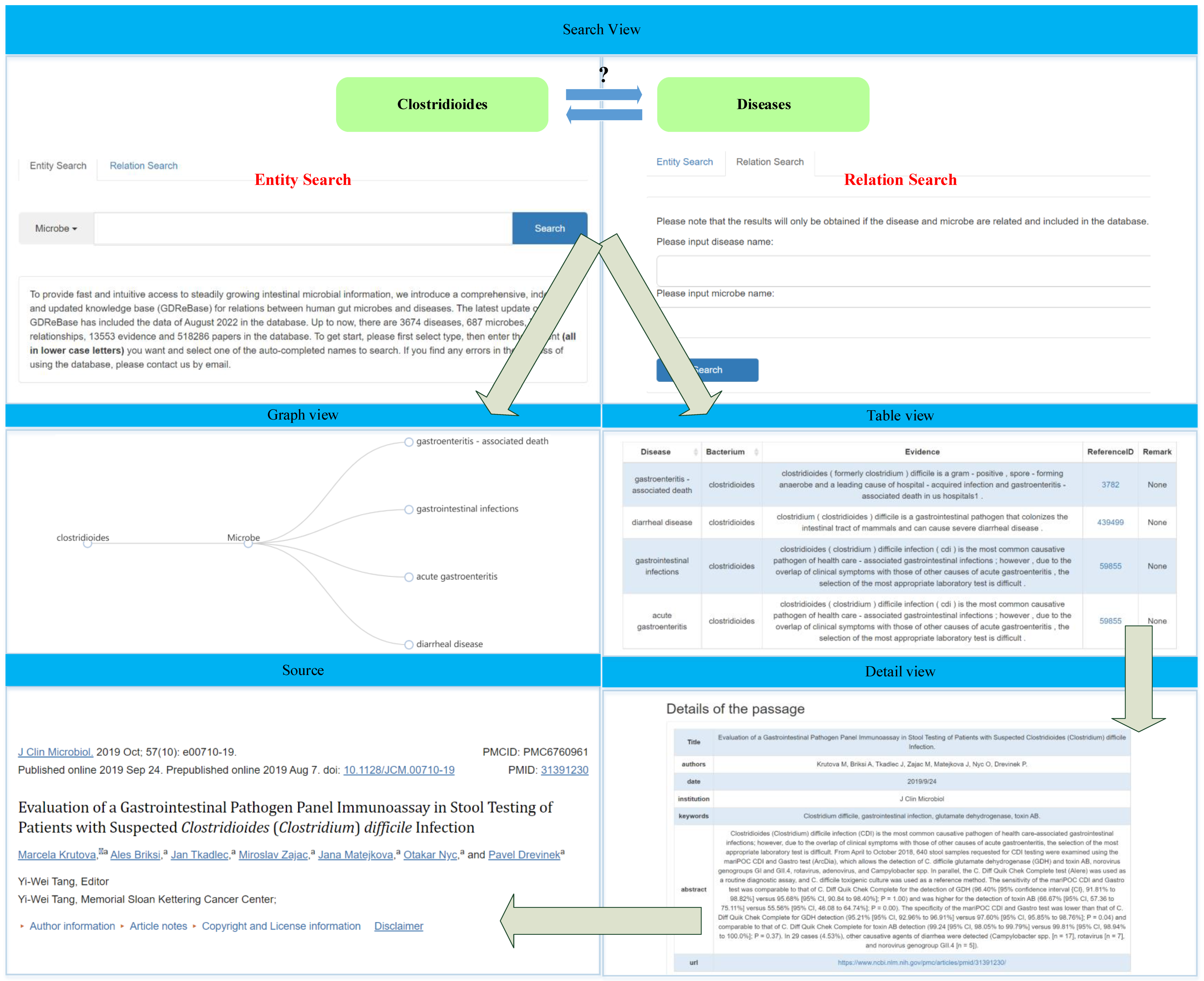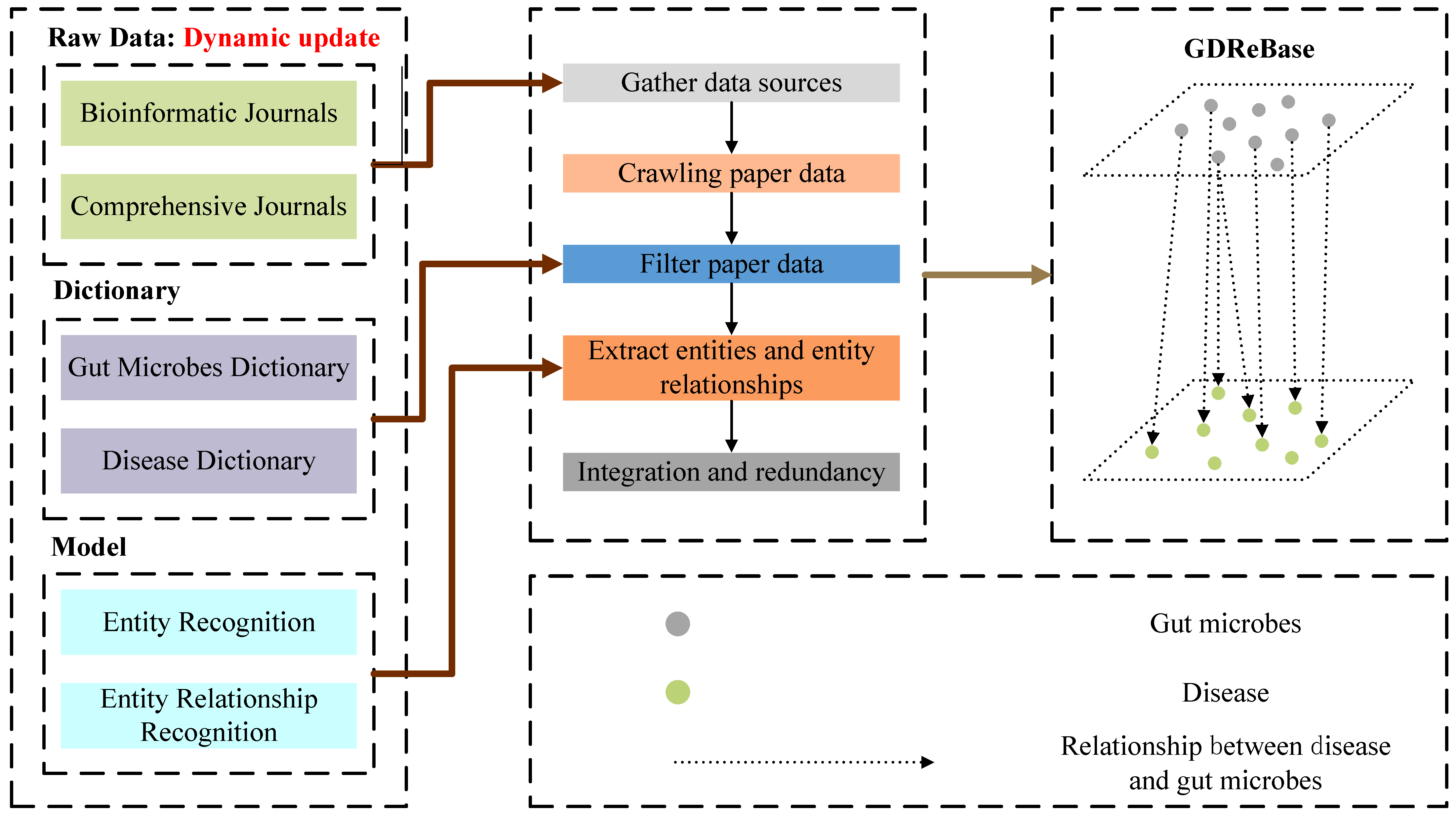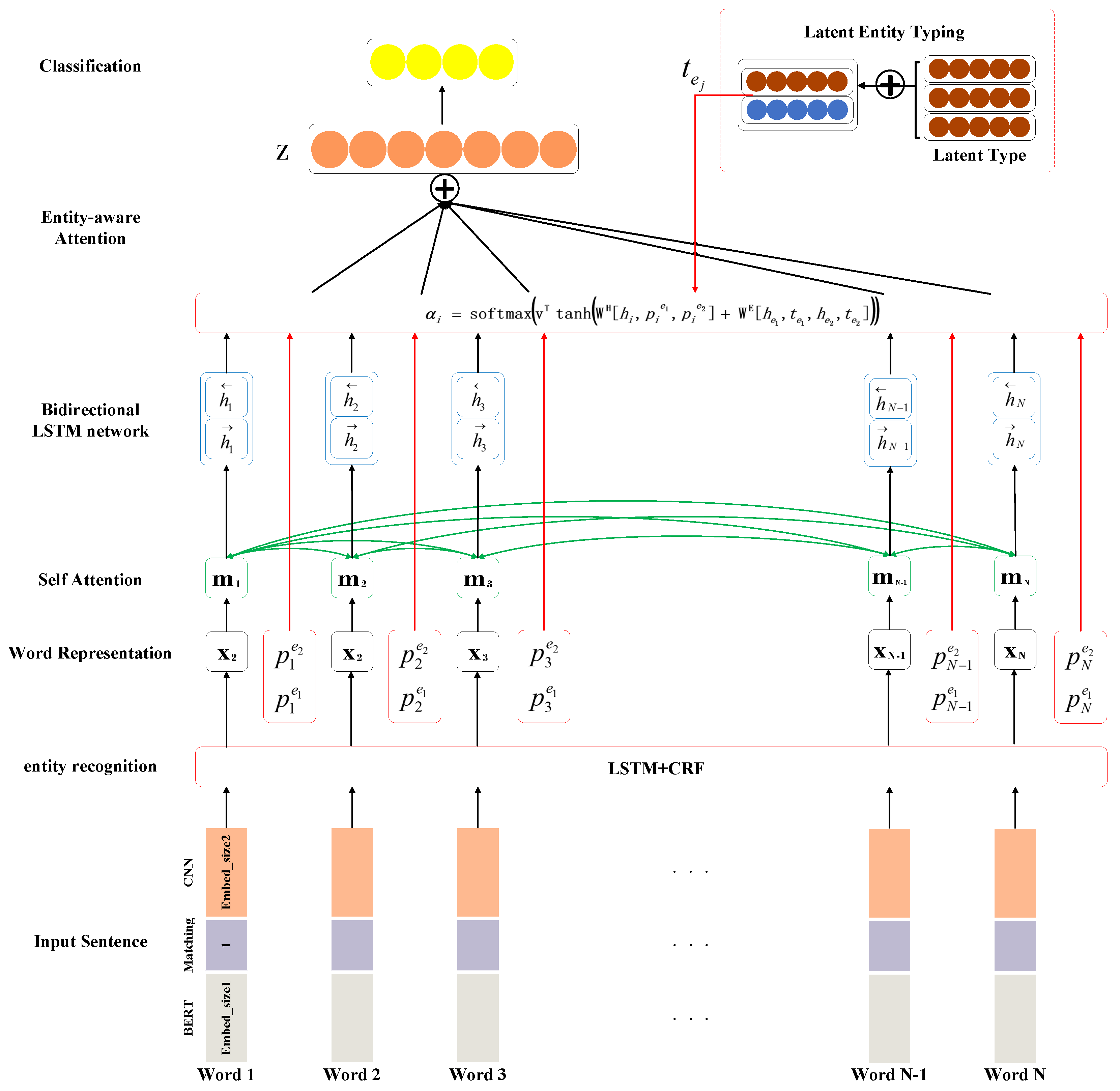GDReBase: A Knowledge Base for Relations between Human Gut Microbes and Diseases Based on Deep Learning
Abstract
:1. Introduction
2. Results
2.1. Database Content and Statistics
2.2. Web Interface
2.3. Automatic Updates
3. Discussion
4. Methods
4.1. Overview of Innovativeness
4.2. Data Sources and Crawling
4.3. Data Filtering and Relationship Dataset
4.4. NER and RE
4.5. NER Evaluation Metrics
- TP: entities that are recognized by NER and match the ground truth;
- FP: entities that are recognized by NER but do not match the ground truth;
- FN: entities annotated in the ground truth that are not recognized by NER.
Author Contributions
Funding
Institutional Review Board Statement
Informed Consent Statement
Data Availability Statement
Conflicts of Interest
References
- Lozupone, C.A.; Stombaugh, J.I.; Gordon, J.I.; Jansson, J.K.; Knight, R. Diversity, stability and resilience of the human gut microbiota. Nature 2012, 489, 220–230. [Google Scholar] [CrossRef] [PubMed] [Green Version]
- Marchesi, J.R.; Adams, D.H.; Fava, F.; Hermes, G.D.A.; Hirschfield, G.M.; Hold, G.; Quraishi, M.N.; Kinross, J.; Smidt, H.; Tuohy, K.M.; et al. The gut microbiota and host health: A new clinical frontier. Gut 2016, 65, 330–339. [Google Scholar] [CrossRef] [Green Version]
- Sanz, Y.; Santacruz, A.; Gauffin, P. Gut microbiota in obesity and metabolic disorders. Proc. Nutr. Soc. 2010, 69, 434–441. [Google Scholar] [CrossRef] [PubMed] [Green Version]
- Turnbaugh, P.J.; Ley, R.E.; Mahowald, M.A.; Magrini, V.; Mardis, E.R.; Gordon, J.I. An obesity-associated gut microbiome with increased capacity for energy harvest. Nature 2006, 444, 1027–1031. [Google Scholar] [CrossRef]
- Turnbaugh, P.J.; Hamady, M.; Yatsunenko, T.; Cantarel, B.L.; Duncan, A.; Ley, R.E.; Sogin, M.L.; Jones, W.J.; Roe, B.A.; Affourtit, J.P.; et al. A core gut microbiome in obese and lean twins. Nature 2009, 457, 480–484. [Google Scholar] [CrossRef] [PubMed] [Green Version]
- Petersen, C.; Bell, R.; Klag, K.A.; Lee, S.-H.; Soto, R.; Ghazaryan, A.; Buhrke, K.; Ekiz, H.A.; Ost, K.S.; Boudina, S.; et al. T cell-mediated regulation of the microbiota protects against obesity. Science 2019, 365, eaat9351. [Google Scholar] [CrossRef]
- Sokol, H.; Pigneur, B.; Watterlot, L.; Lakhdari, O.; Bermúdez-Humarán, L.G.; Gratadoux, J.-J.; Blugeon, S.; Bridonneau, C.; Furet, J.-P.; Corthier, G.; et al. Faecalibacterium prausnitzii is an anti-inflammatory commensal bacterium identified by gut microbiota analysis of Crohn disease patients. Proc. Natl. Acad. Sci. USA 2008, 105, 16731–16736. [Google Scholar] [CrossRef] [PubMed] [Green Version]
- Morgan, X.C.; Tickle, T.L.; Sokol, H.; Gevers, D.; Devaney, K.L.; Ward, D.V.; Reyes, J.A.; Shah, S.A.; LeLeiko, N.; Snapper, S.B.; et al. Dysfunction of the intestinal microbiome in inflammatory bowel disease and treatment. Genome Biol. 2012, 13, R79. [Google Scholar] [CrossRef] [PubMed]
- Scher, J.U.; Sczesnak, A.; Longman, R.S.; Segata, N.; Ubeda, C.; Bielski, C.; Rostron, T.; Cerundolo, V.; Pamer, E.G.; Abramson, S.B.; et al. Expansion of intestinal Prevotella copri correlates with enhanced susceptibility to arthritis. eLife 2013, 2, e01202. [Google Scholar] [CrossRef]
- Jangi, S.; Gandhi, R.; Cox, L.M.; Li, N.; von Glehn, F.; Yan, R.; Patel, B.; Mazzola, M.A.; Liu, S.; Glanz, B.L.; et al. Alterations of the human gut microbiome in multiple sclerosis. Nat. Commun. 2016, 7, 12015. [Google Scholar] [CrossRef]
- Vogt, N.M.; Kerby, R.L.; Dill-McFarland, K.A.; Harding, S.J.; Merluzzi, A.P.; Johnson, S.C.; Carlsson, C.M.; Asthana, S.; Zetterberg, H.; Blennow, K.; et al. Gut microbiome alterations in Alzheimer’s disease. Sci. Rep. 2017, 7, 13537. [Google Scholar] [CrossRef] [PubMed] [Green Version]
- Fasano, A.; Visanji, N.P.; Liu, L.W.C.; Lang, A.E.; Pfeiffer, R.F. Gastrointestinal dysfunction in Parkinson’s disease. Lancet Neurol. 2015, 14, 625–639. [Google Scholar] [CrossRef] [PubMed]
- Brenner, D.; Hiergeist, A.; Adis, C.; Mayer, B.; Gessner, A.; Ludolph, A.C.; Weishaupt, J.H. The fecal microbiome of ALS patients. Neurobiol. Aging 2018, 61, 132–137. [Google Scholar] [CrossRef]
- Blacher, E.; Bashiardes, S.; Shapiro, H.; Rothschild, D.; Mor, U.; Dori-Bachash, M.; Kleimeyer, C.; Moresi, C.; Harnik, Y.; Zur, M.; et al. Potential roles of gut microbiome and metabolites in modulating ALS in mice. Nature 2019, 572, 474–480. [Google Scholar] [CrossRef]
- Xu, J.-Y.; Liu, M.-T.; Tao, T.; Zhu, X.; Fei, F.-Q. The role of gut microbiota in tumorigenesis and treatment. Biomed. Pharmacother. 2021, 138, 111444. [Google Scholar] [CrossRef]
- Elkrief, A.; Derosa, L.; Zitvogel, L.; Kroemer, G.; Routy, B. The intimate relationship between gut microbiota and cancer immunotherapy. Gut Microbes 2019, 10, 424–428. [Google Scholar] [CrossRef] [Green Version]
- Zhou, C.-B.; Zhou, Y.-L.; Fang, J.-Y. Gut microbiota in cancer immune response and immunotherapy. Trends Cancer 2021, 7, 647–660. [Google Scholar] [CrossRef] [PubMed]
- Colov, E.P.; Degett, T.H.; Raskov, H.; Gögenur, I. The impact of the gut microbiota on prognosis after surgery for colorectal cancer—A systematic review and meta-analysis. APMIS 2020, 128, 162–176. [Google Scholar] [CrossRef] [PubMed]
- Kodama, Y.; Shumway, M.; Leinonen, R.; International Nucleotide Sequence Database Collaboration. The sequence read archive: Explosive growth of sequencing data. Nucleic Acids Res. 2012, 40, D54–D56. [Google Scholar] [CrossRef] [Green Version]
- Harrison, P.W.; Alako, B.; Amid, C.; Cerdeño-Tárraga, A.; Cleland, I.; Holt, S.; Hussein, A.; Jayathilaka, S.; Kay, S.; Keane, T.; et al. The european nucleotide archive in 2018. Nucleic Acids Res. 2019, 47, D84–D88. [Google Scholar] [CrossRef]
- Mashima, J.; Kodama, Y.; Fujisawa, T.; Katayama, T.; Okuda, Y.; Kaminuma, E.; Ogasawara, O.; Okubo, K.; Nakamura, Y.; Takagi, T. DNA data bank of Japan. Nucleic Acids Res. 2017, 45, D25–D31. [Google Scholar] [CrossRef] [PubMed] [Green Version]
- Belman, S.; Mathew, O.K.; Walther-António, M.; Jeraldo, P.; Abdu, F.; Vunikili, R.; Badgeley, M.; Johnson, K.; Glicksberg, B.; Hirsch, J.; et al. MuPhenome: A curated catalog of microbiome correlates with clinical phenotypes. In Programs and Abstracts of the Sixty-Eighth American Society of Human Genetics Annual Meeting, San Diego, CA, 2018. Abstract F-1517; American Society of Human Genetics: Rockville, MD, USA, 2018; p. 772. [Google Scholar]
- Janssens, Y.; Nielandt, J.; Bronselaer, A.; Debunne, N.; Verbeke, F.; Wynendaele, E.; Van Immerseel, F.; Vandewynckel, Y.-P.; De Tré, G.; De Spiegeleer, B. Disbiome database: Linking the microbiome to disease. BMC Microbiol. 2018, 18, 50. [Google Scholar] [CrossRef] [PubMed]
- Oliveira, F.S.; Brestelli, J.; Cade, S.; Zheng, J.; Iodice, J.; Fischer, S.; Aurrecoechea, C.; Kissinger, J.C.; Brunk, B.P.; Stoeckert, C.J., Jr.; et al. MicrobiomeDB: A systems biology platform for integrating, mining and analyzing microbiome experiments. Nucleic Acids Res. 2018, 46, D684–D691. [Google Scholar] [CrossRef] [PubMed] [Green Version]
- Wu, S.; Sun, C.; Li, Y.; Wang, T.; Jia, L.; Lai, S.; Yang, Y.; Luo, P.; Dai, D.; Yang, Y.-Q.; et al. GMrepo: A database of curated and consistently annotated human gut metagenomes. Nucleic Acids Res. 2020, 48, D545–D553. [Google Scholar] [CrossRef] [Green Version]
- Doğan, R.I.; Leaman, R.; Lu, Z. NCBI disease corpus: A resource for disease name recognition and concept normalization. J. Biomed. Inform. 2014, 47, 1–10. [Google Scholar] [CrossRef] [Green Version]
- Devlin, J.; Chang, M.W.; Lee, K.; Toutanova, K. Bert: Pre-training of deep bidirectional transformers for language understanding. arXiv 2018, arXiv:1810.04805. [Google Scholar]
- Lample, G.; Ballesteros, M.; Subramanian, S.; Kawakami, K.; Dyer, C. Neural architectures for named entity recognition. In Proceedings of the 2016 Conference of the North American Chapter of the Association for Computational Linguistics: Human Language Technologies, San Diego, CA, USA, 12–17 June 2016; pp. 260–270. [Google Scholar]
- Li, J.; Sun, Y.; Johnson, R.J.; Sciaky, D.; Wei, C.H.; Leaman, R.; Davis, A.P.; Mattingly, C.J.; Wiegers, T.C.; Lu, Z. BioCreative V CDR task corpus: A resource for chemical disease relation extraction. Database 2016, 2016, baw068. [Google Scholar] [CrossRef] [Green Version]
- Lee, J.; Seo, S.; Choi, Y.S. Semantic relation classification via bidirectional LSTM networks with entity-aware attention using latent entity typing. Symmetry 2019, 11, 785. [Google Scholar] [CrossRef]






| Database | Update | Type | Update Speed | Cover Area |
|---|---|---|---|---|
| Disbiome | √ | Manual | >One month | Published information |
| MicrobiomeDB | √ | Manual | Three months | Microbiome datasets |
| GMrepo | × | Manual | × | Human gut metagenome projects |
| GDReBase | √ | Automatic | Dynamic | Published information |
| Example | Problem |
|---|---|
| The role of enteropathogenic <m>escherichia coli</m> epec as a cause of <d>diarrhoea</d> in cancer and immunocompromised patients is controversial. | controversial |
| An increase in <m>aeromonas</m> may be closely related to the development of <d>enteritis</d>. | may |
| A <m>bacillus</m> calmette guerin bcg model was also established to assess the diagnosis of <d>tuberculosis infection</d> using ec skin test. | no apparent association |
| Example | Method |
|---|---|
| <m>Klebsiella pneumoniae</m> is a common cause of antimicrobial-resistant <d>opportunistic infections</d> in hospitalized patients. | Cartesian product |
| <m>Shigella</m> is a highly prevalent bacterium causing acute <d>diarrhea</d> and <d>dysentery</d> in developing countries. | Cartesian product |
| Recent studies have suggested that <m>escherichia coli</m> and <m>klebsiella pneumoniae</m>, which both cause common <d>extraintestinal infections</d> such as <d>urinary tract and bloodstream infections</d>, may also be foodborne. | Cartesian product |
| For example, <d>typhoid fever</d> is caused by the <m>capsulated salmonella enterica serovar typhi</m>, while <m>nontyphoidal salmonella serovars</m> associated with <d>gastroenteritis</d> are non-capsulated. | Clustering syntactic analysis |
Disclaimer/Publisher’s Note: The statements, opinions and data contained in all publications are solely those of the individual author(s) and contributor(s) and not of MDPI and/or the editor(s). MDPI and/or the editor(s) disclaim responsibility for any injury to people or property resulting from any ideas, methods, instructions or products referred to in the content. |
© 2023 by the authors. Licensee MDPI, Basel, Switzerland. This article is an open access article distributed under the terms and conditions of the Creative Commons Attribution (CC BY) license (https://creativecommons.org/licenses/by/4.0/).
Share and Cite
Xu, H.; Li, X.; Dai, X.; Liu, C.; Wang, D.; Zheng, C.; Liu, K.; Liu, S.; Zeng, Y.; Song, Z.; et al. GDReBase: A Knowledge Base for Relations between Human Gut Microbes and Diseases Based on Deep Learning. Appl. Sci. 2023, 13, 1614. https://doi.org/10.3390/app13031614
Xu H, Li X, Dai X, Liu C, Wang D, Zheng C, Liu K, Liu S, Zeng Y, Song Z, et al. GDReBase: A Knowledge Base for Relations between Human Gut Microbes and Diseases Based on Deep Learning. Applied Sciences. 2023; 13(3):1614. https://doi.org/10.3390/app13031614
Chicago/Turabian StyleXu, Haolei, Xin Li, Xiaolong Dai, Chunhao Liu, Dongxiao Wang, Chenghao Zheng, Kaihua Liu, Sitong Liu, Yufei Zeng, Ziyang Song, and et al. 2023. "GDReBase: A Knowledge Base for Relations between Human Gut Microbes and Diseases Based on Deep Learning" Applied Sciences 13, no. 3: 1614. https://doi.org/10.3390/app13031614





